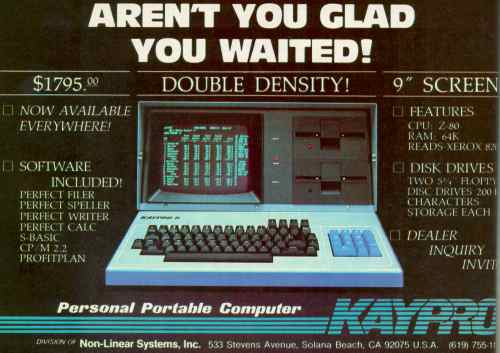[2b2k] Back when not every question had an answer
Let me remind you young whippersnappers what looking for knowledge was like before the Internet (or “hiphop” as I believe you call it).
Cast your mind back to 1982, when your Mommy and Daddy weren’t even gleams in each other’s eyes. I had just bought my first computer, a KayPro II.
I began using WordStar and ran into an issue pretty quickly. For my academic writing, I needed to create end notes. Since the numbering of those notes would change as I took advantage of WordStar’s ability to let me move blocks of text around (^KB and ^KK, I believe, marked the block), I’d have to go back and re-do the numbering both in the text and in the end notes section. What a bother!
I wanted to learn how to program anyway, so I sat down with the included S-Basic manual. S-Basic shared syntax with BASIC, but it assumed you’d write functions, not just lines of code to be executed in numbered order. This made it tougher to learn, but that’s not what stopped me at first. The real problem I had was figuring out how to open a file so that I could read it. (My program was going to look for anything between a “[[” and a “]]”,, which would designate an in-place end note.)The manual assumed I knew more than I did, what with its file handlers and strange parameters for what type of file I was reading and what types of blocks of data I wanted to read.
I spent hours and hours and hours, mainly trying random permutations. I was so lacking the fundamental concepts that I couldn’t even figure out what to play with. I was well and truly stuck.
“Simple!” you say. “Just go on the Internet…and…oh.” So, it’s 1982 and you have a programming question. Where do you go? The public library? It was awfully short on programming manuals at that time, and S-Basic was an oddball language. To your local bookstore? Nope, no one was publishing about S-Basic. Then, how about to…or…well…no…then?…nope, not for another 30 years.
I was so desperate that I actually called the Boston University switchboard, and got connected to a helpful receptionist in the computer science division (or whatever it was called back then), who suggested a professor who might be able to help me. I left a message along the lines of “I’m a random stranger with a basic question about a programming language you probably never heard of, so would you mind calling me back? kthxbye.” Can you guess who never called me back?
Eventually I did figure it out, if by “figuring out” you mean “guessed.” And by odd coincidence, as I contemplate moving to doing virtually all my writing in a text editor, I’m going to be re-writing that little endnoter pretty soon now.
But that’s not my point. My point is that YOU HAVE NO IDEA HOW LUCKY YOU ARE, YOU LITTLE BASTARDS.
For those of you who don’t know what it’s like to get a programming question answered in 2013, here are some pretty much random examples:
-
Javascript tutorial: Code Academy
-
How to get the contents of a file: W3Schools
-
Why isn’t that working? Stackoverflow
-
A Javascript footnoter: github










